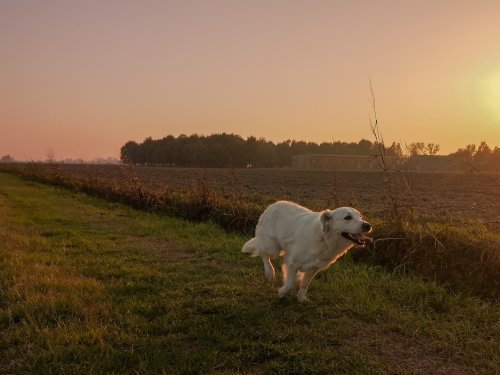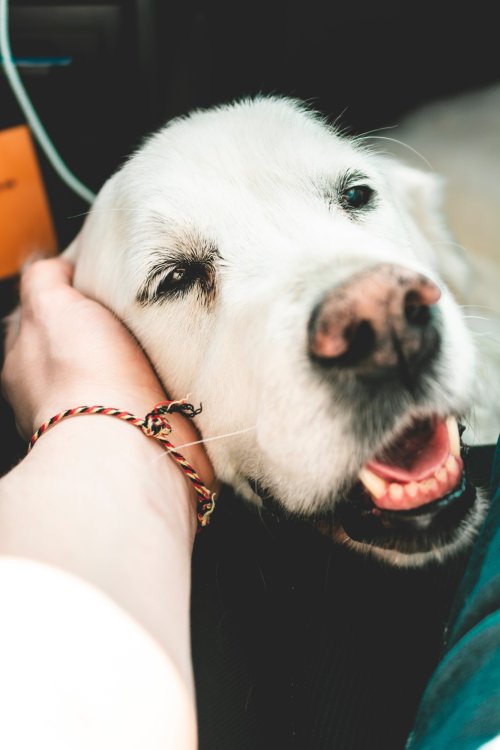Canine Osteopathy: A Holistic Approach to Your Dog's Health
Our canine companions bring joy and unconditional love into our lives. However, we are responsible for providing them with the necessary and best care possible, including good food, shelter, and love and ensuring their overall well-being. Holistic health care for dogs is gaining more recognition among pet owners as we learn more about the necessity of considering the whole animal, addressing both physical and emotional needs.
Canine osteopathy is a holistic approach to treating dysfunctions within the dog's body and mind through manual therapy. The osteopathic philosophy regards the body as a series of interconnected systems; when one of those systems shifts out of balance, the other systems are put under more stress as they must compensate for the original dysfunction. This chain reaction adversely affects the dog's overall well-being; osteopathic treatment aims to restore the optimal functioning of the body and mind.
Book Now
Key Points
- - Canine osteopathy is a holistic approach to treating physical conditions in dogs that emphasises the connection between body structure and function.
- - The holistic approach to animal health focuses on physical, emotional, and mental well-being through non-traditional treatments, diet, exercise & stimulation.
- - Hands-on techniques, preventative treatments, and annual checkups are essential for sustaining the general well-being of animals.
Understanding Canine Osteopathy: A Holistic Approach

Focusing on treating dogs, canine osteopathy is a branch of animal osteopathy. It employs gentle manipulation to tackle health issues related to joints, muscles, or organs. This hands-on approach to treating various physical conditions in dogs is grounded in the osteopathic philosophy, which emphasises the important link between structure and function in the body. Canine osteopaths use manual therapy techniques with the goal of restoring balance through the dog’s musculoskeletal system, which ultimately enhances their overall health and well-being.
Canine osteopaths specialise in treating dogs and undergo specialised training to ensure they provide safe and effective treatments. They are skilled at:
Diagnosing somatic dysfunctions through observation and palpation of the affected area
Using light manipulation techniques to facilitate the animal’s restoration of optimal mobility
Alleviating discomfort or pain
The Principles of Animal Osteopathic Therapy
The foundations of Osteopathy are attributed to Andrew Still (1828 – 1917); the animal branch of osteopathy is far more contemporary, beginning in 1984 and is attributed to the work of Prof. Stuart McGregor. The fundamental principles across both human and animal osteopathy recognise that:
(1) The body is a unit of interconnected systems
(2) The body is capable of repair and self-healing functions when the functioning of all systems is optimal or unimpeded
(3) Structure (anatomy) and function (physiology) are interdependent
(4) When one area of the body is strained, compensatory issues can develop
This holistic approach acknowledges that treatments that optimise structural alignment and promote the natural flow of fluids around the body assist the body and mind in maintaining or finding wellness.
The body has an innate ability to conduct self-healing and self-regulating functions and osteopathic treatments are designed to support these natural processes. Within osteopathy, there are five major systems of the body, which treatments are designed to affect positively. Those systems are:
(1) The biomechanical system
(2) The neurological system
(3) The respiratory-circulatory system
(4) The metabolic-energetic system
(5) The behavioural-biopsychosocial system
While providing care, canine osteopaths consider the integrated nature of the dog’s musculoskeletal system and its effect on other bodily systems. They focus on enhancing physical and emotional wellness while promoting health maintenance, taking a genuinely holistic approach to their care.
Animal Biomechanical Therapy / Canine Biomechanics
Biomechanics, or how an animal moves, plays an intrinsic role in osteopathic thought. Canine biomechanics largely considers the musculoskeletal system, which is the largest and most interconnected system within the body. Through optimising movement patterns and restoring the body's natural range of motion, the canine osteopath aims to promote physical and emotional health.
With a deep knowledge of how the body moves, through the study of animal biomechanics, canine osteopaths can analyse gait, movement patterns and posture comprehensively. Allowing them to approach the enhancement of joint and soft tissue biomechanics in dogs from a deeply scientific view.
Treatment of biomechanical issues in dogs can be for general wellness and maintenance or for more serious issues that impact the musculoskeletal or neurological systems as an adjunctive therapy to Veterinary medicine. The focus is on improving the overall health and well-being of canines by optimising their biomechanics.
Identifying When Your Dog Needs Osteopathic Treatment
Canine osteopathy can be beneficial in addressing a variety of issues, including:
Muscular problems
Joint problems
Back problems
Neck problems
Hip problems
Behavioural changes
Post-operative issues
Recognising the signs that your dog may need osteopathic treatment is vital for every dog owner, as it ensures they receive the appropriate care for their specific needs. Consulting an osteopath may be advantageous if your dog is rehabilitating from an injury or if a behaviour change is observed.
A typical canine osteopathy treatment session lasts approximately 45 minutes, during which the osteopath will:
Assess and treat any identified issues
Use a hands-on approach to alleviate pain & enhance movement
Promote overall health and well-being for your canine companion
Recognising the signs that your dog may need osteopathic treatment can help you ensure they receive the care they need for a happy, healthy life.
Common Conditions Treated by Canine Osteopaths
Canine osteopathy is a modality that is designed to treat a variety of conditions, including muscular issues, gait irregularities, age-related issues such as arthritis joint pains, back pain, neck pain, hip problems, changes in behavioural patterns, reduced performance levels, circulatory problems, digestive issues, and post-operative complications. Osteopathic treatment can address a range of injuries, including musculoskeletal injuries, joint disorders, sprains, and degenerative conditions like arthritis. It can also be beneficial for injuries resulting from training and repetitive strain injuries or to assist with compensatory issues stemming from congenital conditions such as hip dysplasia.
In cases of arthritis in dogs, canine osteopathy uses gentle hands-on treatment techniques such as fascia release and joint mobilisation to reduce tension and restrictions in the body, promote healing, and enhance movement and function. If you can identify signs and symptoms indicative of a need for osteopathic treatment in dogs, like reduced performance, general stiffness, or difficulty climbing stairs, you can ensure your dog gets the right care and treatment for their condition.
The Benefits for Agility and Working Dogs

Agility and working dogs are canine athletes who can greatly benefit from osteopathic treatments. These treatments help enhance performance and reduce the risk of injuries. Osteopathy aims to reduce the risk of injury by helping the bodies of working and agility dogs by:
Restoring balance to the dog’s body
Enhancing movement
Alleviating pain
Providing support to joints and muscles to offset any existing injuries.
Performance is a high priority for these dogs, and regular osteopathic treatment is designed to alleviate many performance-inhibiting ailments and reduce the likelihood of asymptomatic issues progressing. Regular osteopathic treatments should be incorporated into your canine athlete's plan when the quality of life and performance are a high priority.
Many agility trainers, flyball handlers, and mushers regularly seek to improve their dog's performance and obedience by receiving osteopathic treatment. These high-level competitions need dogs to feel their best in order to perform their best, they also require a healthy neurological and muscular system that provides effective feedback to ensure they have effective stability, balance, and proprioception, allowing them to generate more power, increase their endurance, and improve their agility.
Hands-On Techniques Used by Canine Osteopaths
Canine osteopaths employ a variety of hands-on techniques to treat dogs, including:
Joint mobilisation: a manual technique used to assess and treat joint issues in dogs, involving the application of gentle mobilisation and manipulation of the joints to enhance their range of motion and reduce discomfort.
Soft tissue release: a technique used to release tension and improve the flexibility of muscles and other soft tissues.
Muscle stretching: a technique used to stretch and lengthen muscles, improving their flexibility and reducing muscle tightness.
Joint articulation, soft tissue release, and muscle stretching may be utilised during joint mobilisation in canine osteopathy.
Muscle stretching techniques are essential to the hands-on approach canine osteopaths use to enhance joint mobility, reduce muscle tension, and improve the natural flow of blood and other bodily fluids in dogs. These techniques can include joint manipulation, soft tissue work, and manual stretching exercises to improve the dog’s overall health and well-being.
Post-Treatment Care and Recommendations
To ensure the effectiveness of canine osteopathy treatments, post-treatment care is essential. Here are some general recommendations for post-treatment care:
Rest: Dogs should have a rest period of up to 2 days following a canine osteopathy session, allowing them a period of relative restfulness.
Gradual return to normal activity: After rest, dogs should gradually return to their normal exercise levels.
Tailored advice: It is important to receive tailored advice for the dog’s specific needs to ensure proper post-treatment care.
Tailored advice for specific conditions post-canine osteopathy may include:
A customised program of regular osteopathic treatment
Regular stretching and exercises
Appropriate schooling
Consulting an osteopath or canine conditioning expert for ideas on post-treatment care
Following the post-treatment care and recommendations provided by your canine osteopath can ensure your dog’s continued health and well-being.
The Role of Maintenance Treatments
Playing a key role in sustaining general well-being and optimising performance in dogs, maintenance treatments are vital. Some examples of these treatments include:
Regular check-ups for elderly dogs
Regular check-ups for racing, agility or sport dogs
Pre/Post-competition/event tune-ups
General maintenance treatments
Maintaining your dog’s overall health and well-being necessitates regular check-ups and treatments.
The treatment regimen for a dog depends on their age, history, and the demands placed on them. For elderly dogs, regular treatments may be necessary to ensure that they remain healthy and happy throughout their golden years. This can include annual check-ups to monitor changes in their musculoskeletal system and identify any underlying conditions or diseases that may impact their overall health and well being.
Annual Check-Ups for Elderly Dogs

Regular monitoring of an elderly dog’s musculoskeletal health is essential to detect any changes or issues that may develop. Annual check-ups for elderly dogs can help reduce the likelihood of further deterioration, manage pain, and improve the animal’s quality of life. Moreover, regular monitoring can assist in identifying any underlying conditions or diseases that may be impacting the musculoskeletal system, thus allowing for timely intervention and treatment.
Signs of musculoskeletal issues in elderly dogs may include:
Abnormal contraction in the shoulder muscle
Biceps inflammation
Contracted quadriceps
Achilles tendon issues
Reduced general activity
Modifications in social interactions
Aggression or behaviour changes
Lameness
Abnormal gait
Decreased movements in joints
Difficulty moving or unwillingness to move
Intense joint pain
Scheduling annual check-ups for your elderly dog ensures they get the necessary care and attention to maintain their overall health and well-being.
The Holistic Approach to Your Dog's Health
Taking a holistic approach to your dog’s health promotes overall physical and emotional well-being. The Canine Osteopath should take into account your dog’s current physical, emotional, and mental state and strive to treat the entire pet rather than concentrating on individual symptoms.
Considering diet, exercise, and mental health when assessing a dog’s overall health can help ensure that your dog remains fit and maintains a healthy weight. Moreover, a balanced diet can support physical and mental well-being, while mental stimulation can promote cognitive function and prevent boredom.
Adopting a holistic approach to your dog’s well-being promotes their overall happiness and quality of life throughout the years they share with you.
Training and Certification Requirements
To ensure safe and effective treatments for dogs, canine osteopaths undergo specialised training and certification. The training programs for canine osteopathy encompass topics such as anatomy and physiology of dogs, biomechanics and movement analysis, pathology and disease processes in dogs, osteopathic assessment and diagnosis techniques, osteopathic treatment techniques specific to dogs, canine nutrition and diet, and canine behaviour and psychology.
Summary
In conclusion, canine osteopathy offers a holistic, hands-on approach to treating various physical conditions in dogs, focusing on the link between structure and function. By understanding canine osteopathy and its principles, you can make informed decisions about your dog’s health and well-being. Regular check-ups and maintenance treatments can help maintain overall health and improve performance in dogs.
With the knowledge and understanding of canine osteopathy, you can ensure that your furry friend receives the best possible care throughout their life. Embrace the holistic approach to your dog’s health and explore the world of canine osteopathy, a valuable tool in promoting the well-being of our beloved canine companions.
Frequently Asked Questions
What does a dog osteopath do?
A dog osteopath helps to restore an animal's range of motion and enables them to move comfortably through daily activities. They focus on physical and emotional health, treating the whole patient rather than a symptom in isolation.
What are the techniques for osteopathy in dogs?
The techniques used by different animal osteopaths will depend on the level of their training and their skills. Joint articulation and soft tissue techniques that restore the body's natural range of motion are the most important.
How often does my dog need osteopathic treatment?
This depends on your individual dog, the level of dysfunction they are experiencing and how long it has been affecting them. The longer an injury or dysfunction is left untreated, the more body areas can become involved in compensating, causing systemic strain. The interconnective fascial and soft tissue can also change, leading to longer recovery times. This often means that injuries left sometime before treatment may require more osteopathic treatment sessions to help restore the body to a functional condition.
General wellness treatments are advised for pet dogs; a yearly check-up will help gauge change in the body and allow you to set a plan that promotes your dog's general health.
Canine athletes and working dogs, whose jobs require a top-functioning body, should be on regular maintenance treatments to promote their performance.
Book Now

